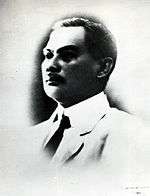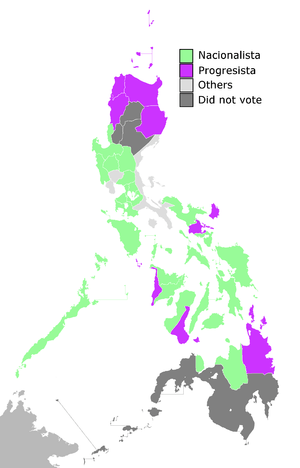Philippine Assembly elections, 1907
| | |||||||||||||||||||||||||||||||||||
| |||||||||||||||||||||||||||||||||||
| |||||||||||||||||||||||||||||||||||
|
| |||||||||||||||||||||||||||||||||||
Coalitions that won a plurality of votes in each province.
| |||||||||||||||||||||||||||||||||||
| |||||||||||||||||||||||||||||||||||
The first Philippine Assembly elections were held across the Philippines on July 30, 1907. The Philippine Organic Act of 1902 established a bicameral Philippine Legislature composed of the appointed Philippine Commission as the upper house and the elected Philippine Assembly as the lower house.
Formation of political parties
With the conclusion of the Philippine-American War (then known as the "Philippine Insurrection") and the establishment of the American colonial Insular Government under the Philippine Organic Act of 1902, elections were held in various parts of the Philippines. Divisions developed between the Federalistas who advocated for statehood within the United States, and the Independistas those who advocated for independence. The opposition to American rule were unable to mount a united front for the 1906 local elections, with only the Comitė de Intereses Filipinos presenting a united, yet limited, organization. By mid-1906, those opposed to American rule began organizing themselves into political parties.[1]
The Comitė de la Union Nacional and the Partido Popular Independista merged to create the Partido de la Union Nacionalista. The Union Nacionalistas rejected a hardline path and instead chose an evolutionary position. Meanwhile, the Independistas urged immediate independence from the U.S. After failing to broker a deal with the Independistas, the Union Nacionalista proposed a merger with the Federalistas. Juan Sumulong, who led the Federalistas, advocated a radical policy, more in line with the "conservative" wing of the Union Nacionalistas led by Rafael Palma. The Federalistas consulted Governor-General James Francis Smith, who then sought to advice of Taft on the matter. Both Smith and Taft opposed the union, with Smith saying to Sumulong that a fusion will "result in the complete obliteration of the conservative element as a political actor in the community." The refusal of Federalistas reopened talks between the Union Nacionalista and the Independistas.[2]
The Independistas organized themselves in January 1907 with a leadership election. To prevent further split, Alberto Barretto and Justo Lukban were elected co-leaders of the party. The election of Fernando Guerrero, Sergio Osmeña, Teodoro Sandiko and Isauro Gabaldon as counselors marked the first time that a Manila-based political group established links with provincial leaders.[3]
The Nacionalistas and the Progresistas
In late January, the Federalistas organized themselves into a new name, Partido Nacional Progresista and launched a campaign to win seats in provinces around Manila. The nationalist-leaning groups launched negotiations to present a unified slate in the elections; Meanwhile, Palma insisted on having the word "Immediata" (immediate) to the party name of the proposed merger of the Union Nacionalistas and the Independistas. On March 12, 1907, the Union Nacionalista and the Independistas merged to form the Partido Nacionalista.[4]
While the Nacionalistas will have a rotating leadership, the manner of selection of the candidates was a source of major dispute and the party convention at the Manila Grand Opera House ended in disarray.[5] The Progresistas, on the other hand, dropped Federal from the party name seeing that the word had outlived its usefulness and had changed their name to Partido Nacional Progresista (National Progressive Party).[6]
Campaign
While the Nacionalistas were in disarray, the Progresistas orchestrated a well-organized "popular assembly". The Progresistas established networks on local strongmen on already associated with the Nacionalistas; however, they were only able to field candidates in half of the districts in Central and southwestern Luzon. The Progresistas were unable to recruit supporters even in places were a Progresista is in office, save for Tarlac. In Manila, the Progresistas resorted to encouraging Americans to register and vote for them. However, the Federalistas were able to field in candidates in far-flung areas in Visayas and Mindanao.[7]
While the Progresistas were having a hard time on increasing their ranks, they instead relied on a strategy that will ensure the defeat of Nacionalistas candidates that will oppose Progresista policies.[8]
The Nacionalistas split their ranks when Guerrero and Lukban, members of the old Independista group were dropped from the ticket in favor of Dominador Gomez and Felipe del Pan. Quezon, brokered a deal that set a party convention that will settle candidacies but it was never convened; Gomez and del Pan remain the official candidates for the "regular" Nacionalistas. Guerrero and Lukban ultimately set up the Liga Nacional Independecia whose sole purpose is to contest 1907 elections.[9]
The Progresistas led by Trinidad Pardo de Tavera, on the other hand, opposed "immediate" independence. The reception at Progresista political rallies were from lukewarm to hostile, with people heckling "Hang them, kill them".[10]
On election day, the Partido Nacionalista, with its national organization in disarray, was able to field a candidate in 68 of the 80 districts.[11]
Results
The top bar represents seats won, while the bottom bar represents the proportion of votes received.
| ||||||||
|
- 1 No seats won: 2.13%
| Party | Popular vote | Seats won | ||||
|---|---|---|---|---|---|---|
| Total | % | Total | % | |||
| Nacionalista | 34,277 | 34.89% | 32 | 40.00% | ||
| Independent | 22,878 | 23.29% | 20 | 25.00% | ||
| Inmediatista | 7,126 | 7.25% | 7 | 8.75% | ||
| Nacionalista coalition | 64,281 | 65.43% | 59 | 73.75% | ||
| Progresista | 24,234 | 24.67% | 16 | 20.00% | ||
| Centro Catolico | 1,192 | 1.21% | 1 | 1.25% | ||
| Philippine Independent Church | 91 | 0.09% | 0 | 0.00% | ||
| Independista | 6,179 | 6.29% | 4 | 5.00% | ||
| Scattered votes | 2,005 | 2.04% | 0 | 0.00% | ||
| Total | 97,982 | 100% | 80 | 100% | ||
| Valid votes | 97,982 | 99.73% | ||||
| Invalid votes | 269 | 0.27% | ||||
| Total turnout | 98,251 | 93.60% | ||||
| Registered voters | 104,966 | 100% | ||||
| Source: Philippine Commission. Report of the Philippine Commission to the Secretary of War 1907. | ||||||
Aftermath
While the candidates representing the Nacionalistas won majority of the seats in the assembly, the maneuvering to the election for the Speaker of the Assembly began, as the Speaker would be the most powerful Filipino in government. Quezon and Osmeña focused on aggregating the delegates around Osmeña's leadership, a task that became easier than the two had anticipated. With less than two dozen delegates, the Progresistas won't be able to elect a Speaker from their ranks and were marginalized from the talks amongst the Nacionalistas. Osmeña found two opponents for the Speakership: Gomez who defeated Lukban by 31 votes, and Pedro Paterno. However, Gomez's citizenship was questioned, and Paterno found himself to be Osmeña's leading opponent.[12]
Gomez was found to be a Spanish citizen and a new election for his seat was called. Gomez still ran in the election and beat Lukban by a larger margin, about 400 votes. Gomez was permitted to take his seat, but not after seven months has passed, and after Osmeña was elected Speaker[13] on October 16, 1907, with Quezon as the majority floor leader.[14]
The defeat of the Progresistas in the elections hastened their downfall; the Nacionalista Party will continue to dominate the elections for the legislature, and the Progresistas, and later their successor the Democratas, will remain in opposition.[15]
Notes
- ↑ Cullinane (1989), p. 287
- ↑ Cullinane (1989), p. 291
- ↑ Cullinane (1989), p. 292
- ↑ Cullinane (1989), p. 293
- ↑ Cullinane (1989), p. 294
- ↑ Cullinane (1989), p. 295
- ↑ Cullinane (1989), p. 296-302
- ↑ Cullinane (1989), p. 304
- ↑ Cullinane (1989), p. 305
- ↑ Mojares (2006), p. 151
- ↑ Cullinane (1989), p. 306
- ↑ Cullinane (1989), p. 318
- ↑ Cullinane (1989), p. 326
- ↑ Halili (2004), p. 184
- ↑ Brownlee (2007), p. 75
References
- Brownlee, Jason (2007). Authoritarianism in an age of democratization. Cambridge University Press. ISBN 978-0-521-86951-5.
- Cullinane, Michael (1989). Ilustrado Politics: Filipino Elite Responses to American Rule, 1898-1908. Ateneo de Manila University Press. ISBN 978-971-550-439-3.
- Halili, M.C. (2004). Philippine History. Rex Bookstore, Inc. ISBN 978-971-23-3934-9.
- Mojares, Resil B. (2006). Brains of the nation: Pedro Paterno, T.H. Pardo de Tavera, Isabelo de los Reyes, and the production of modern knowledge. Ateneo de Manila University Press. ISBN 978-971-550-496-6.
- Pobre, Cesar P. (2000). Philippine Legislature 100 Years. Philippine Historical Association in cooperation with New Day Publishers. ISBN 971-92245-0-9.


